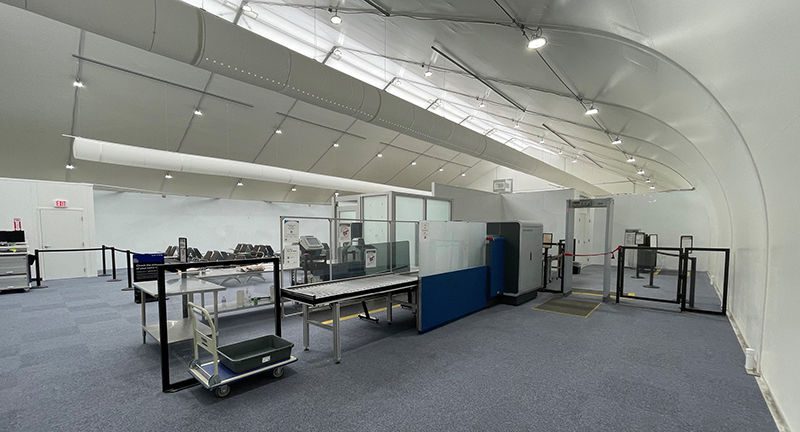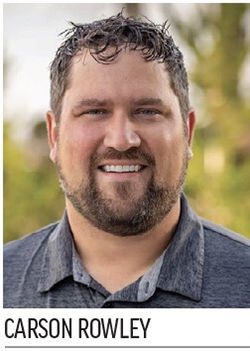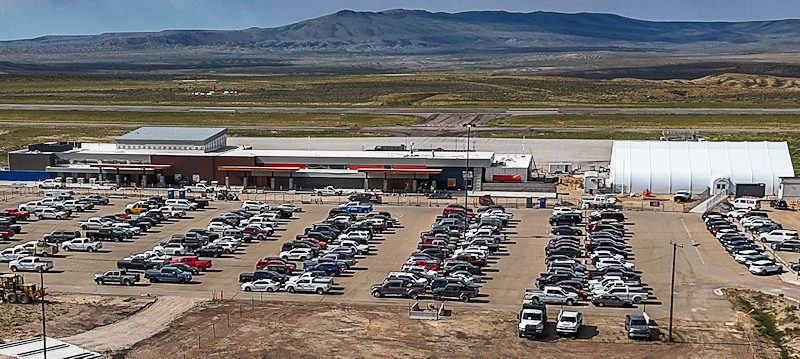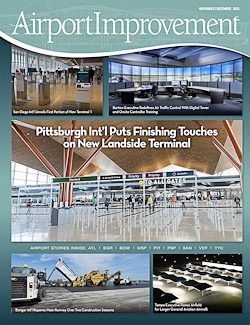A dramatic tale recently unfolded in a rugged corner of the U.S. Mountain West. Its storyline features the widening development of remote mountain lands, a contested financial dispute and just a touch of political and financial intrigue.
Although it sounds like a plot from the popular TV saga Yellowstone, this is actually the latest chapter in the history of Southwest Wyoming Regional Airport (RKS), the aviation gateway to a rural region in Sweetwater County that’s enjoying a multibillion-dollar boom.
This September, the small airport in Rock Springs, WY, excitedly unveiled an expanded and fully renovated 34,000-square-foot terminal with its first-ever passenger boarding bridge and baggage conveyor system. Behind the scenes, however, the redevelopment process was arduous for RKS.
| facts&figures
Project: Terminal Modernization & Expansion Location: Southwest Wyoming Regional Airport (RKS), in Rock Springs, WY Airport Operator: Rock Springs-Sweetwater County Airport Board Size: 34,000 sq. ft. of expanded & renovated floor space Cost: $43.9 million Funding: $27 million from FAA; $10 million in grants & loans from Wyoming Business Council; $2.5 million in Bipartisan Infrastructure Law funds; $2.5 million allocated by Wyoming governor’s office; $1.3 million from city of Rock Springs & Sweetwater County Master Consultant, Civil Engineering: Ardurra Architecture, Building Engineering, Environmental General Contractor: Baggage System: Passenger Boarding Bridge: Oshkosh AreroTech Automated Exit Lane: Security & Access Control: Genetec Prefabricated Temporary Terminal: Sprung Structures Temporary Wall Units: SwiftWall Curtain Wall: Manko, installed by DJ’s Glass Seating: Arconas; Allsteel Primary Tenant: United Express 2024 Passenger Volume: Approx. 43,000 |
Planning for the $44 million expansion began nearly a decade ago and initially called for upgrading and widening an aged, austere terminal building. But after construction was well underway—and following an unforeseen, yearlong interruption— airport leaders changed course and opted to gut the facility and begin largely anew. Aside from the structural supports and a few HVAC units and boilers that had been replaced just before the terminal renovations began, almost nothing is left of the old facility.
The sole holdroom was tripled in size to accommodate up to 130 departing travelers, and outside the aircraft parking apron was reconfigured to better support dual gate operations. Improvements beyond the perimeter fences included an expanded parking lot and a new circulation roadway, plus better crosswalks, lighting and wayfinding.
Fire suppression systems and data connectivity were also modernized, and the terminal went from only three wireless access points to more than 20. Television monitors jumped from two up to a dozen, and advanced security cameras were installed throughout the site.
“We’re coming from the 1970s to 2025 really quickly,” says Airport Director Devon Brubaker. His staff of nine handles everything from customer service and firefighting to fueling and baggage handling for all commercial flights and those at an adjacent fixed-based operator.
Welcome to Boomtown
Commercial service is provided by United Express operated by SkyWest Airlines, with two nonstops a day to Denver International Airport (DEN), a primary hub for United Airlines. One of the two runways at RKS is slightly more than 10,000 feet. Such length is necessary due to the airport’s ultra-high elevation of 6,764 feet above sea level—more than one-quarter mile higher than the Mile High City of Denver.
Located along a remote stretch of Interstate 80, Sweetwater County, WY, is home to about 40,000 residents. That’s expected to increase soon, however, thanks to nearly $12 billion in ongoing investments within the area. There’s talk of another $15 billion in potential developments now under consideration, and Brubaker says upgrading the airport was purposefully timed to stay ahead of an expected surge in travel demand.
Energy is what’s powering that optimism. The Cowboy State has long been known for its coal, natural gas and oil reserves. The state’s petroleum association reported three years ago that Wyoming had more than 10,000 producing oil wells, nearly 18,000 producing natural gas wells, four oil refineries and more than 30 operating natural gas plants. Transmission infrastructure crisscrosses the state from corner to corner.
Further job growth in this sector is likely after the U.S. Geological Survey recently announced that the Mowry Composite Total Petroleum System—a series of underground geological formations beneath and around Sweetwater County—possesses a previously undiscovered 473 million barrels of oil and 27 trillion cubic feet of gas.
Fossil fuels have competition, too, as southwestern Wyoming has also welcomed next-generation energy resources headlined by TerraPower, a venture backed by Bill Gates that is building the nation’s first commercial advanced nuclear power plant in Kemmerer, WY. Although the city is 90 miles west of Rock Springs, RKS is its closest commercial airport.
TerraPower’s $4 billion project broke ground in June 2024 and a year later, its backers announced another $650 million in investments led by Gates, South Korean manufacturer HD Hyundai and tech giant NVIDIA Corp. Its first plant is expected to come online in 2030.
Separately, the nearby town of Granger is home to Frontier Infrastructure’s Sweetwater Carbon Storage Hub, a $50 million carbon capture project aiming to store more than 350 million metric tons of carbon dioxide by injecting the pollutant into geological reservoirs miles underground. The project’s first two wells, respectively more than 16,000 and 18,437 feet deep, were recently completed, with work on a third well slated to soon follow.

Everything from passenger screening to baggage claim was housed in a temporary facility from Sprung Structures during construction.
Additionally, Sweetwater County is the world’s largest depository of trona, a mineral used as a raw material for soda ash. It’s a key component for the manufacture of toothpastes, soaps and detergents, as well as glass parts used in electric vehicles and solar panels.
The world’s five most-productive trona mines are already in the region. Beyond that, Pacific Soda’s Dry Creek Trona Project and rival WE Soda Ltd.’s Project West are separately building two more facilities capable of collectively processing 9 million tons of trona annually—enough to boost the region’s current output by nearly 50%.
Hundreds, if not thousands, of full-time jobs—and potential air travelers—are expected to follow.
Lastly, Wyoming is a decidedly red state, with Republicans holding a nearly seven-to-one advantage in voter registration during last year’s presidential election. Those political leanings and a traditional emphasis on outdoor recreational opportunities such as shooting and hunting have made the state a haven for the U.S. gun manufacturing industry.
Three years ago, Rock Springs welcomed a firearms production facility from Florida-based Kel-Tec CNC Industries that was expected to employ up to 250 workers upon complete buildout. At the time, the company’s chief executive officer said he’d only commit to the community if RKS would continue to press United to bump its schedule up to twice-daily DEN service—a change that came to fruition in early summer 2024.

“Air service was a really important component of that recruitment,” Brubaker notes.
Spending millions of dollars to capture hoped-for growth was a difficult choice, particularly coming off the COVID-19 pandemic. But Brubaker believes long-term dividends are certain to follow.
“In 2020, I told the airport board, ‘We can tap our brakes just like everyone else, or we can keep our foot on the gas pedal with the idea air travel is going to come back eventually and we need to be ready for it.’” Brubaker explains. “They made the decision to move forward.”
Ardurra served as master consultant for the terminal project and also handled both landside and airside civil engineering, including water, sewer and stormwater conveyance.
According to Carson Rowley, a project manager with the firm’s aviation team, improvements at RKS weren’t merely speculative. He says they were necessary to meet today’s operational standards, and more so, to secure customers’ willingness to fly locally.
 “Salt Lake is the closest big city, and I think in the past there’s been a perception that that was the better way to travel,” Rowley explains. “The (prior RKS) building was just doing the most with what they had—a lot of Band-aid fixes to manage the situation.
“Salt Lake is the closest big city, and I think in the past there’s been a perception that that was the better way to travel,” Rowley explains. “The (prior RKS) building was just doing the most with what they had—a lot of Band-aid fixes to manage the situation.
“With the new building, all of the needs are met.”
A Rocky Road to Growth
In late 2023—roughly a year after construction began—work came to a standstill when the Rock Springs-Sweetwater County Airport Board sued Sletten Construction of Wyoming after the contractor tried to increase its proposed guaranteed maximum price.
Sletten reportedly threatened to halt work unless its originally bid price was increased by $7 million. The airport board’s complaint requested the court to force Sletten to complete the job under the originally agreed-upon terms. That legal dispute eventually delayed construction for nearly a year before it was settled in December 2024, and Sletten was terminated from the project, reported SweetwaterNOW, a Rock Springs news outlet.
Once that hurdle was cleared, RKS still faced an uncertain path. It had a half-completed building and no contractor. Working with the FAA, Brubaker was directed to reapproach other companies that had originally submitted bids. In that process, Reno-based Q&D Construction emerged to resurrect the project from a lengthy dormancy.
Sletten’s plans had the airport remaining open within a portion of its terminal as renovations occurred around day-to-day operations. But Q&D indicated the remaining timeline could be reduced by a full year if the airport would relocate all operations to a temporary facility.
 “After such a long delay, getting this thing turned over as quickly as possible was definitely a key element for this project to be successful,” explains Q&D Aviation Vice President LaMonte Forgays. “The half-and-half approach was really not realistic.”
“After such a long delay, getting this thing turned over as quickly as possible was definitely a key element for this project to be successful,” explains Q&D Aviation Vice President LaMonte Forgays. “The half-and-half approach was really not realistic.”
Q&D had been using Sprung Structures for temporary facilities on its projects for nearly 20 years, beginning with a terminal renovation at Reno International Airport (RNO) in 2008. Following a visit to the company’s corporate headquarters in Salt Lake City, Brubaker agreed to move everything—from check-in and TSA screening to baggage claim and car rentals—into one of the company’s 9,000-square-foot tensioned fabric structures located near the airport’s parking lot.
Engineers from Mead & Hunt crafted an associated layout, and the tentlike space was quickly outfitted with temporary wall panels from SwiftWall to subdivide its functional areas. Construction was expedited while the traffic in the temporary terminal facility never skipped a beat.
“In three months, we went from, ‘This is a good idea’ to ‘It was delivered and we’re building it,’” Forgays says. “People thought the Sprung Structure was the new (terminal).”
“It’s actually better than what we moved out of,” adds Brubaker. “Over nearly a year, I haven’t received a single public complaint.”
Even after that move shaved a year’s costs from the ledger, the overall price of the project had increased significantly—due to post-COVID inflation and having to redo some interior work damaged by exposure to the elements during the yearlong construction pause. With a revised total cost of nearly $44 million, RKS was $22 million short on funds as work was set to resume.
“There were a lot of questions about whether we could pull in the funding,” Forgays recalls. “Devon [Brubaker] pulled all the levers he could pull and was able to find it.”
Brubaker asked the Rock Springs City Council and Sweetwater County Commission each to pledge the funds needed to resume construction. Although he hoped to subsequently find other sources of money, all involved recognized the scale of the ask.
“Twenty-two million (dollars) isn’t a lot of money for many municipalities, but this would have been the largest project in each of their histories, even if they split the costs,” Brubaker says. “And they still said yes.”
He attributes that support as payback for lengthy efforts to build relationships and trust.
“It was a rabbit out of a hat,” Brubaker quips. “But we’d spent years telling the story and sharing the vision of why the airport is so critical to our economic success. Ultimately, that resulted in unanimous support from all parties.”
Brubaker never had to call in those markers, though, because he secured additional support from the state and FAA that relieved the city and county of most of their financial commitments to the expansion.
“There were definitely some times when the (financing) gap looked large, but Devon has a way of leveraging things,” Rowley says admiringly. “Being able to get all of those partners to see the same vision…it’s just crazy. He’s very good at his job.”
The Cavalry Arrives
Even though Q&D Construction’s headquarters is in Reno, more than 700 miles and two states away from RKS, the company was eager to take on the airport’s half-completed project.
When construction resumed, the contractor deployed two superintendents—one from Nevada and one a local hire—to run its operations in Wyoming. About 90% of the subcontractors it hired were locals, with up to 75 workers onsite at peak. Project managers traveled from Reno one or two times a month and used videoconferences to further coordinate.
Q&D’s risk assurance bondholders were initially leery of the company taking on a partially finished job, but Forgays credits designers at Mead & Hunt for their detailed efforts to mitigate any associated risks. That process began by building a status report showing exactly where things stood at the time Q&D joined the project, from progress of various tasks down to all onsite and preordered inventory. Q&D also sought to return Sletten’s subcontractors to the project if they agreed to rebid their initial contracts; this helped ensure warranty protections weren’t jeopardized.
“There was a lot of front-end work,” Forgays notes. “We were able to collaboratively create that line of what’s ours and what was not our obligation to go back and fix.”
Mead & Hunt handled design work for the terminal’s architectural, structural, mechanical, electrical, plumbing and communications systems. Geoff Mohney, a project manager with the firm, had never been involved in a project that swapped general contractors midway through. He says a steep learning curve was made easier in part by the obvious nature of the older terminal’s most-glaring needs.
“The existing building was far too small,” Mohney says. “If you had a full flight going out, the holdroom was packed—standing room only.”
Bottlenecks also obstructed movement between ticketing and an undersized TSA checkpoint, as well as the gating area where deplaning passengers often ran into crowds of outbound travelers awaiting their turn to board. Mohney describes the prior holdroom as “uncomfortable,” with too few seats, inadequate space in the restrooms and very limited amenities.
Mead & Hunt sought to fix these shortcomings with the new design. In addition to Gate 1’s new passenger boarding bridge from Oshkosh AreroTech, the adjacent Gate 2 supports ground loading. Concession spaces were included both pre- and post-security, and counterspace was added for a third rental car company in addition to incumbents Avis and Budget.
Rowley looks forward to the pragmatic benefits of the enclosed jet bridge. “If you ever spend any time in Rock Springs, you know (avoiding) the wind and the bitter, bitter cold in wintertime will allow for better customer service and more efficiency in loading.”
Aesthetics were also emphasized. A covered driveway was removed to capture more natural lighting near the terminal entryways. On the secure side, a massive Manko curtain wall in the holdroom frames spectacular views across the airfield and beyond.
“Some say Southern Wyoming is not a scenic place, but it really is, especially when you take it in and look at it,” Mohney remarks. “Being able to see Aspen Mountain and the often-dramatic skies, to see that view with planes taking off and landing…it’s really pretty.”
Landing New Businesses
The airport encompasses nearly 1,250 acres, 450 of which could still be developed for non-aviation purposes. To that end, the Wyoming Business Council contributed $10 million in loans and grants to RKS to maximize the airport’s potential for further economic development. Gov. Mark Gordon added another $2.5 million from the state that matched federal funds Wyoming received through the 2021 Infrastructure Investment and Jobs Act.
Brubaker put the funds to use by adding a 4½-mile natural gas main and a low-pressure sanitary sewer system. Now, he says just one more upgrade is needed to fully unlock the airport’s potential.
Because RKS is located more than seven miles outside of the city limits, it lacks a pipeline to the local water supply. Trucks transport all of the airport’s water, 6,000 gallons at a time, before it’s treated onsite to ensure drinkability. Brubaker says a $70 million project to address that issue is in the planning phase, pending funding.
“We added as many elements as possible that would benefit not just the terminal but the airport long-term,” Brubaker says. “(Water connectivity) is the last remaining hurdle for us.”
As he reflects on the recent terminal development, Brubaker recalls fondly how his small team, small community and stakeholder partners pulled together to complete a difficult task. It truly is an epic story for all who participated.
“We overcame adversity that I would argue no other airport has had to overcome,” he says. “I’ll remember how the team rallied and rescued a project from failure to success.”
| Aviation – A Remote Interest
The first flights to Sweetwater County, WY, date back more than a century when a seven-week, coast-to-coast-and-back air race flew onto a newly cleared landing strip on the cliffs overlooking the Green River in 1919. The popularity of that event spawned a series of local air races that fostered an ongoing fascination for flight among residents of an isolated community that even today requires a nearly four-hour drive to reach Cheyenne, the state’s largest city. In the 1920s, growth of the then-nascent U.S. air mail industry led to the development of an air terminal four miles north of Rock Springs. In turn, its presence helped make Sweetwater County the primary stopping point for pilots flying between Cheyenne and Salt Lake City. A decade later, Boeing and other companies began offering passenger service coinciding with air mail flights. As more people took to the skies, a new airport capable of handling that era’s larger metal airframes was built east of Rock Springs, where Southwest Wyoming Regional Airport (RKS) remains today. Given the small population of the airport’s catchment area, outside factors have heavily influenced air service at RKS for decades—and continue to do so today. A boom in energy development sparked record passenger traffic in 2012, with approximately 56,000 passengers reported that year. But air travel dipped a year later when oil and gas production slowed throughout the state. When Devon Brubaker was hired as airport director at RKS in 2015, the airport had a low profile and its marketing efforts had “become stagnant,” he recalls. Like a politician stumping for votes, Brubaker routinely promoted the airport before community residents and business leaders. Airport staff became regulars at local chamber of commerce luncheons, county fairs and anywhere else they could sing their airport’s praises before residents. “There was a marketing budget that wasn’t being spent,” Brubaker explains, noting that RKS didn’t even have a presence on Facebook. At its peak, RKS enjoyed up to five combined departures per day by SkyWest Airlines (flying for United Airlines) and Delta Air Lines. Still, high fares kept many locals from flying. Within his first month on the job, Brubaker made a seven-hour drive to St. George, UT, to meet with SkyWest Airlines and told the carrier’s planners that his trip would have cost more than $900 had he come by air. The anecdote was helpful in building a business case that demand at RKS would improve if carriers could provide greater value on United-branded Denver connections. “We did all of those things and the numbers skyrocketed,” he says, noting that enplanements grew by nearly 60% from 2016 to 2019. Then, the COVID-19 pandemic led to severe setbacks at airports worldwide. Once travel resumed broadly in 2022, air service at RKS gradually returned; and this August marked the 26th consecutive month of year-over-year passenger growth at the airport. |



